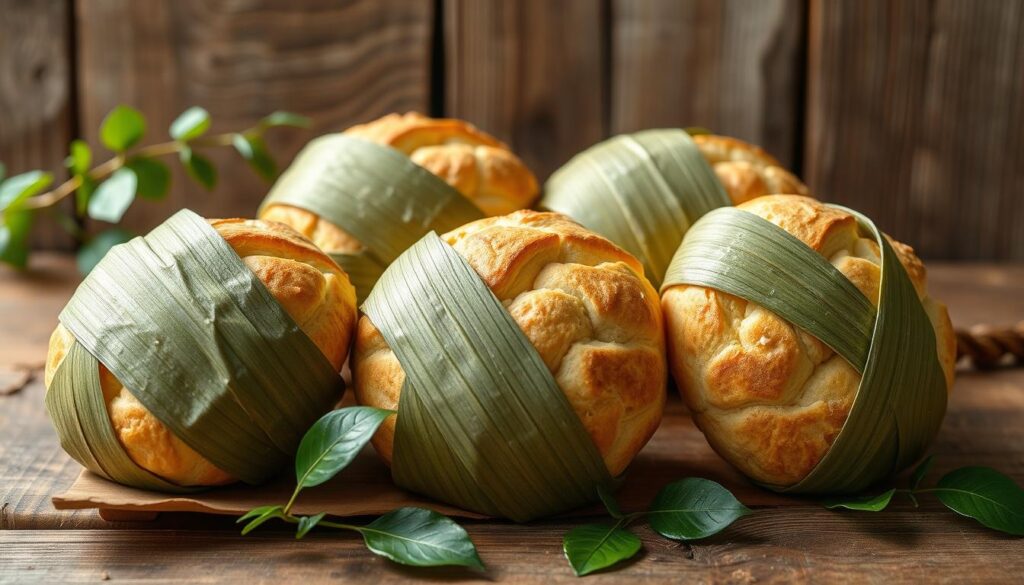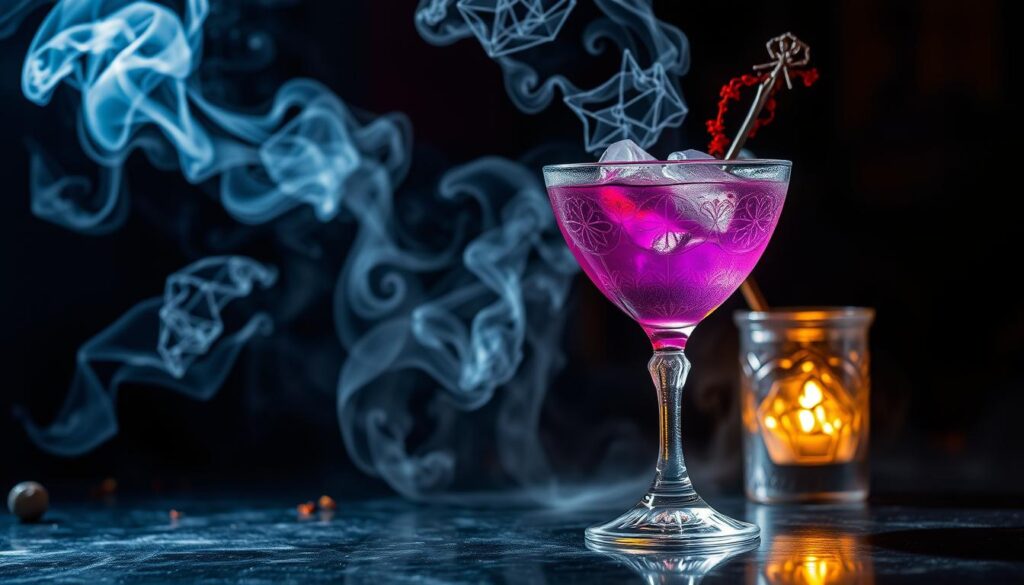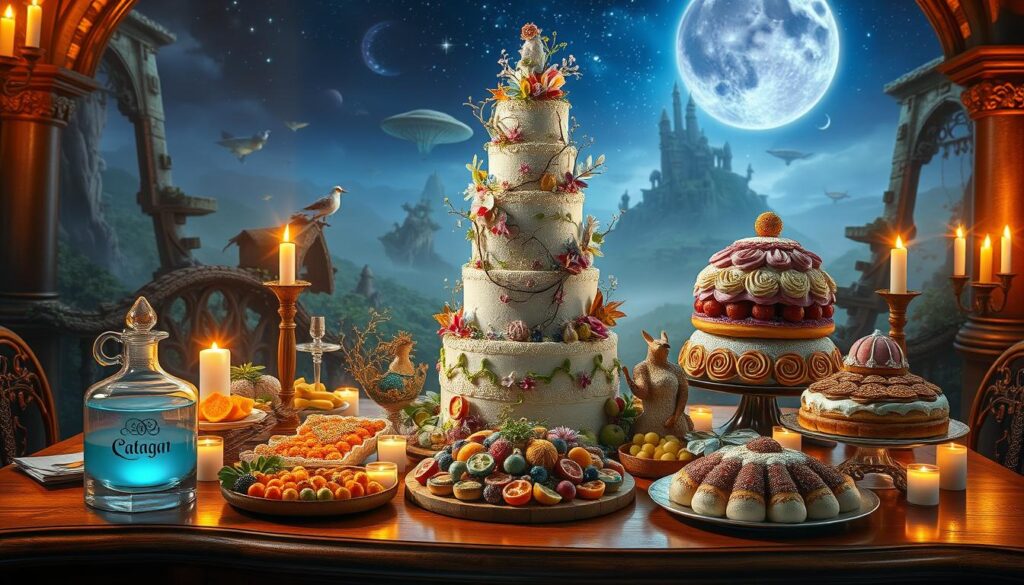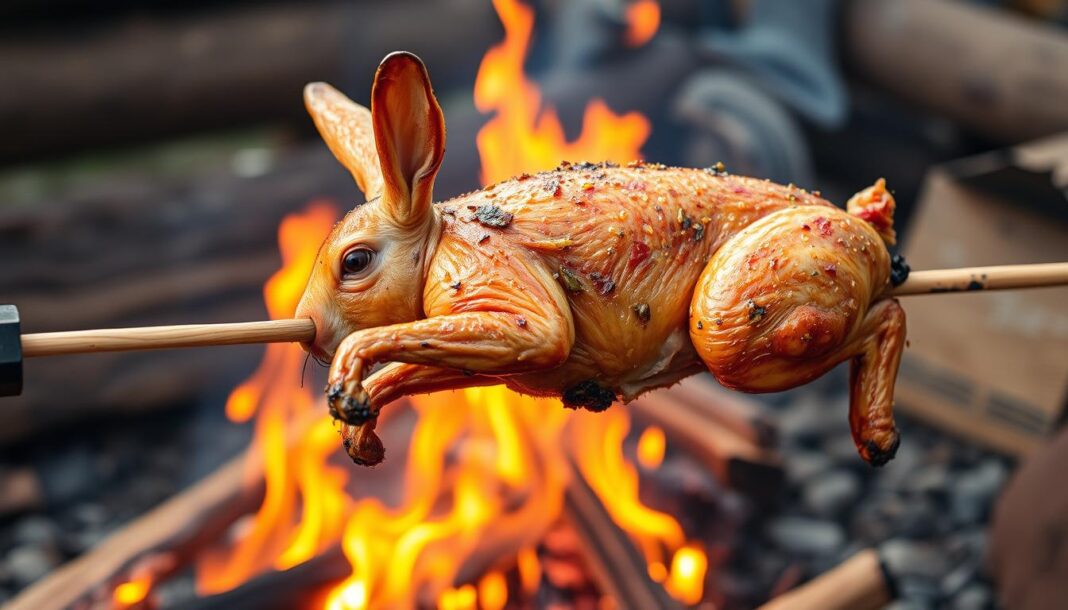Our favorite fictional worlds often inspire us with fantastical flavors, making it hard to resist creating Earthly versions of them. At Historical Foods, we dive into the creative world of fantasy food names, exploring how they can enhance menus, recipes, and themed events.
The popularity of fantasy culinary creations has been on the rise, transforming ordinary dining experiences into extraordinary adventures. Whether it’s for a themed restaurant or home cooking, the right names can evoke the perfect atmosphere. We examine the sources of inspiration behind these food names and provide guidance on creating your own.
By tapping into the world of fantasy, you can add a new dimension to your culinary creations, making them more memorable for your guests. This is where the art of crafting the perfect theme comes into play, using a generator or your own creativity.
The Allure of Fantasy Food Names
In the realm of food, fantasy names have emerged as a powerful tool, elevating dishes into extraordinary experiences that tantalize our senses. The use of imaginative and creative names for food has become increasingly popular, not just in restaurants and cookbooks, but also in home cooking and social media platforms.
These names not only capture our imagination but also create a sense of wonder and excitement around the culinary experience. By tapping into our love for fictional worlds and fantastical creatures, fantasy food names transport us to magical realms, making the act of dining a more immersive and engaging experience.
Why Fantasy Food Names Captivate Our Imagination
Fantasy food names captivate our imagination by leveraging the power of suggestion and emotional connection. They evoke a sense of nostalgia and wonder, linking the food to beloved stories, characters, or mythical worlds. This emotional association enhances our dining experience, making it more memorable and enjoyable.
The psychological appeal of these names lies in their ability to create a narrative around the food, elevating it from a mere dish to a culinary adventure. By engaging our imagination, fantasy food names add a layer of depth and meaning to the dining experience.
The Growing Popularity of Fantasy-Themed Culinary Experiences
The trend of fantasy-themed culinary experiences is on the rise, with restaurants, pop-up dining events, and themed dinner parties becoming increasingly popular. Social media platforms like Instagram and TikTok have played a significant role in amplifying this trend, as people share images and videos of elaborately themed dishes and culinary creations.
This growing popularity is a testament to our desire for immersive and engaging experiences that combine food, imagination, and storytelling. As a result, the culinary world is witnessing a surge in creative and imaginative names that not only reflect the theme or world of the dish but also enhance the overall dining experience.
Drawing Inspiration from Fantasy Worlds
From the epicurean delights of Middle-earth to the futuristic cuisine of sci-fi universes, fantasy worlds are a treasure trove of culinary ideas. The detailed descriptions of food in fantasy literature and media not only enrich the world-building but also inspire our culinary creativity.
Let’s start with J.R.R. Tolkien’s Middle-earth, where cuisine plays a significant role in the narrative. The homely comfort foods of the Shire, such as seed cakes and ale, contrast with the refined Elvish delicacies like lembas bread and miruvor, a restorative drink. Lembas, described as a cracker-like waybread, has become particularly popular among fans, who recreate it as a hard tack or a dense, oat-based bar.
Middle-Earth Cuisine and Elvish Delicacies
Middle-earth’s culinary landscape is characterized by its use of natural ingredients and traditional cooking methods, reflecting the connection of its inhabitants to the land. The Elves, with their advanced knowledge and skill, prepare dishes that are not only delicious but also imbued with a deep sense of culture and history.
Game of Thrones and Medieval Fantasy Fare
The world of Game of Thrones has popularized medieval-inspired fantasy fare, with dishes like Dothraki blood pie and Winterfell stews capturing the imagination of fans. These dishes often feature rich, hearty ingredients and complex preparation methods, reflecting the harsh realities and grand feasts of the show’s medieval-inspired world.
| Fantasy Series | Popular Dish | Description |
|---|---|---|
| Middle-earth | Lembas Bread | A dense, oat-based waybread |
| Game of Thrones | Dothraki Blood Pie | A savory pie, possibly containing meat and spices |
| Star Trek | Gagh | A Klingon delicacy resembling live worms |
Sci-Fi Food Concepts from Star Trek to Firefly
Science fiction franchises like Star Trek and Firefly create alien cuisines that challenge our Earth-bound culinary concepts. In Star Trek, the Klingons enjoy gagh, a dish made from live worms, while in Firefly, Fruity Oaty Bars represent a corporate, mass-produced food product in a frontier space setting. These concepts inspire us to think about the cultural and societal contexts of food in our own world.
By exploring these fantasy worlds and their culinary creations, we can gain a deeper appreciation for the role of food in shaping our cultural identities and our imaginative expressions.
Famous Fantasy Foods Worth Recreating
From the mystical realms of Middle-earth to the magical world of Harry Potter, fantasy foods have left a lasting impression on fans. These iconic dishes not only tantalize our taste buds but also offer a glimpse into the rich culinary worlds created by authors and game designers.
Lembas Bread and Middle-Earth Munchies
Lembas bread, also known as Elvish waybread, is a staple in J.R.R. Tolkien’s Middle-earth. Described as a cracker-like bread, it’s known for its durability and nourishing properties. Fans have recreated lembas bread using simple ingredients like flour, honey, and nuts.

Butterbeer and Magical Treats from Wizarding Worlds
Butterbeer, a beloved drink from the Harry Potter series, has become a cultural phenomenon. Its sweet, creamy flavor has inspired numerous recipes, often featuring butterscotch, cream soda, and whipped cream. Fans can recreate this magical drink at home with a few simple ingredients.

Sci-Fi Delicacies: From Spoo to Fruity Oaty Bars
Sci-fi franchises like Babylon 5 and Firefly have introduced fans to unique foods like Spoo and Fruity Oaty Bars. These dishes, while fictional, can be adapted into real-world recipes. For example, Spoo from Babylon 5 can be recreated using gnocchi, while Fruity Oaty Bars from Firefly might feature oats, fruit, and a crunchy texture.
In conclusion, famous fantasy foods offer a delicious way to engage with our favorite fictional worlds. By examining these dishes and their descriptions, we can gain insight into the cultures and environments that spawned them, as well as the creativity of their creators.
Creating Compelling Fantasy Food Names
To create compelling fantasy food names, we need to examine the linguistic patterns and cultural influences that shape them. Crafting names that are both believable and enticing is crucial for immersing readers or diners in fictional worlds.
Linguistic Patterns in Fantasy Naming
The linguistic patterns used in fantasy food names can greatly impact their believability and appeal. We explore how sounds, syllable combinations, and word structures create specific impressions. For instance, using suffixes like “-ish” or “-ian” can give names an exotic feel, as seen in dishes like “Tolkienish stew” or “Galacticien soup.” Successful fantasy authors often use these patterns to create authentic-sounding names that are both pronounceable and memorable.
Combining Real-World Culinary Terms with Fantasy Elements
Combining real-world culinary terms with fantasy elements is a powerful technique for creating fantasy food names. By merging familiar culinary concepts with fantastical elements, we can create names that suggest both flavor and fictional origin. For example, “Dragon’s Breath Chili” or “Unicorn’s Tear Salad” combine real-world dish types with mythical creatures, creating a sense of wonder and excitement. This approach allows us to balance familiarity and exoticism, making the names more engaging and immersive.
To further enhance the authenticity of fantasy food names, we can reflect the environmental conditions, agricultural practices, and cultural values of fictional worlds. For instance, a desert-dwelling culture might have dishes named after sandy textures or oasis features, while a seafaring culture might incorporate oceanic elements into their cuisine names.
Fantasy Food Names for Different Settings
Different fantasy settings demand unique culinary naming conventions that enhance the world’s authenticity. Whether it’s a rustic tavern, a royal banquet, or an alien marketplace, the names of dishes should reflect their environment.
Tavern and Inn Menu Inspirations
Tavern and inn menus in fantasy settings often reflect local ingredients, preservation methods, and cooking techniques appropriate to pre-industrial societies. Names like “Smoked Rivercatch” or “Hearty Traveler’s Stew” evoke a sense of place and authenticity.
Using a Tavern Name Generator can help create unique and fitting names for these establishments, drawing inspiration from themes like Fantasy, Medieval, or Wild West.
Royal Feast and Noble Banquet Terminology
Royal feast terminology often incorporates elements of status, luxury, and ceremonial significance to reflect the social hierarchy of fantasy worlds. Dishes might be named “Golden Pheasant Royale” or “Dragon’s Breath Soup,” emphasizing their exclusivity and grandeur.
Otherworldly and Alien Cuisine Concepts
Alien and otherworldly cuisine concepts can challenge Earth-bound culinary assumptions while remaining appealing to human readers. Names like “Steamed Gloopernuts” or “Pan-Seared Starlight Fillets” can evoke a sense of exotic, extraterrestrial cuisine.
By considering the specific characteristics of different fantasy settings, we can craft food names that not only sound appealing but also enrich the world’s lore and atmosphere.
Themed Fantasy Food Naming Strategies
Themed naming strategies offer a powerful tool for crafting immersive fantasy food experiences. By employing these strategies, we can create culinary identities that transport diners to new worlds.
Elemental and Nature-Inspired Food Names
Elemental themes (fire, water, earth, air) can inspire fantasy food names that suggest specific flavors, textures, and preparation methods. For instance, “Ember Steak” or “Mistwood Salad” evoke certain culinary characteristics. Nature-inspired naming draws on botanical and zoological terminology to create fantasy foods that feel connected to their fictional ecosystems.
Mythological Creature-Based Dishes
Mythological creatures can inspire dish names that suggest exotic ingredients, unusual preparation methods, or magical properties. Examples include “Dragon’s Breath Chili” or “Mermaid’s Kiss Salad.” These names not only capture the imagination but also provide a narrative context for the dish.
Location and Culture-Specific Fantasy Foods
Location and culture-specific naming conventions can create a cohesive culinary identity for fictional kingdoms, regions, or species. For example, “Kragnir Roast” or “Eldrida Stew” might be inspired by the geography and cultural heritage of fictional places. Using name generators can be a useful starting point for creating themed fantasy food names, providing structure while allowing for creative customization.
| Naming Strategy | Example | Description |
|---|---|---|
| Elemental | Ember Steak | Suggests a grilled or spicy dish |
| Mythological Creature | Dragon’s Breath Chili | Implies a spicy or fiery dish |
| Culture-Specific | Kragnir Roast | Evokes a sense of place and cultural heritage |
Practical Applications for Fantasy Food Names
Practical applications of fantasy food names are diverse, ranging from RPG menus to fantasy-themed restaurants. Fantasy food names can elevate various experiences, making them more immersive and engaging.
Role-Playing Game Night Menus
We explore how fantasy food names can enhance role-playing game nights, creating immersive dining experiences that complement the gaming adventure. For instance, a Dungeons & Dragons campaign can be paired with a custom menu reflecting the campaign setting and current storyline. You can find inspiration for your D&D-themed food ideas by exploring our World of Warcraft cookbook for fantasy culinary concepts.
Fantasy-Themed Restaurants and Pop-Ups
The growing trend of fantasy-themed restaurants and pop-up dining experiences uses creative food naming to transport diners to fictional worlds. These establishments often draw inspiration from popular fantasy literature and games, creating menus that are both thematic and delicious.
Book Launch and Movie Premiere Food Concepts
Book launches and movie premieres can utilize themed food concepts to create memorable marketing experiences that engage fans. By incorporating fantasy food names, these events can further immerse attendees in the fictional universe being celebrated.
By applying fantasy food naming to real-world catering and event planning, we can create themed parties and celebrations that are truly unforgettable. Whether it’s a fantasy-themed wedding or a corporate event, the right food names can add a touch of magic to any occasion.
Crafting a Complete Fantasy Menu
The art of crafting a fantasy menu lies in balancing creativity with coherence. A well-designed menu can transport diners to another world, telling a culinary story that unfolds from appetizers to desserts. To achieve this, we need to consider the naming conventions that build a consistent world and create dishes that are both imaginative and approachable.
Appetizers and Small Bites with Fantastical Names
Appetizers and small bites set the tone for a fantasy dining experience. Names like “Mystic Morsels” or “Dragon’s Breath” introduce diners to the fictional setting, sparking curiosity and anticipation. These initial dishes should be creative, tantalizing, and hint at the fantastical elements to come.
Main Courses Worthy of Epic Tales
Main courses serve as the centerpiece of fantasy menus, with names that evoke heroic quests or legendary beasts. Dishes like “The Dragon’s Hoard” or “Questing Knight’s Stew” can become the highlight of the meal, offering a culinary experience that’s both memorable and immersive. These names not only reflect the fantasy theme but also enhance the dining experience.
Desserts and Sweet Treats from Imaginary Realms
Desserts and sweet treats offer a chance to incorporate whimsical and magical naming conventions, suggesting enchantment and delight. Names such as “Unicorn’s Kiss” or “Fairy Floss” can add a touch of magic to the meal, leaving a lasting impression on diners. By balancing familiar flavors with fantastical presentation and naming, we create dishes that are both delightful and memorable.
Fantasy Beverages and Potions
In the realm of fantasy, beverages and potions are not just drinks, but gateways to magical worlds and extraordinary experiences. Fantasy beverages offer a unique canvas for creativity, blending imagination with the art of mixology. We explore how these enchanting drinks can be named to evoke magic, mystery, and wonder.
Magical Elixirs and Mystical Drinks
Magical elixirs and mystical drinks are at the heart of fantasy storytelling, often possessing supernatural effects or made from exotic, magical ingredients. Names like “Moonlit Elixir” or “Dragon’s Breath” evoke specific magical traditions, from alchemical concoctions to fairy brews and wizarding potions. When crafting names for these drinks, we draw inspiration from mythology, folklore, and fantasy literature, ensuring they resonate with the fantastical elements of the narrative.

Non-Alcoholic Fantasy Beverages for All Ages
Not all fantasy beverages are alcoholic; many are designed to be enjoyed by all ages. Drinks like “Unicorn’s Kiss” or “Pixie’s Potion” can be crafted using juices, teas, and other non-alcoholic ingredients, maintaining the wonder and imagination of the fantasy setting. Town names and city names from fantasy worlds can inspire beverage names that suggest regional specialties and local brewing traditions, such as “Eldrador’s Elixir” or “Moonhaven Mead.”
When creating fantasy beverage names, we consider the fictional history and culture of their origins. For instance, “Dwarven Ale” or “Elvish Wine” reflect the unique brewing traditions and ingredients of their respective cultures. Special effects like color-changing or smoking concoctions can be paired with evocative names to create memorable fantasy beverages. We also provide recipes and naming suggestions for creating your own fantasy beverage menu for themed events, ensuring an immersive experience for your guests.
Recreating Fantasy Foods in Your Kitchen
Transforming fictional feasts into real-world recipes requires imagination and culinary skill. When we encounter fantastical dishes in books, games, or films, our first task is to decipher the key characteristics that make them unique. For instance, Lembas bread from J.R.R. Tolkien’s Middle-earth is described as a wafer-like, cracker-like substance. Fruity Oaty Bars from the TV series Firefly, on the other hand, likely contain fruit, oats, and are bar-shaped.
Adapting Fictional Recipes for Real Ingredients
To recreate these fantasy foods, we need to analyze their descriptions and identify real-world ingredients that can substitute for fictional or magical components. For example, Katniss’s groosling soup from The Hunger Games can be adapted by using real ingredients like grouse or other game birds, and mashing roots like those described in the story. The key is to maintain the essence of the fantasy food while using available ingredients.
| Fantasy Food | Fictional Description | Real-World Adaptation |
|---|---|---|
| Lembas Bread | Wafer-like, cracker-like substance | Use flatbread or crackers, add honey or maple syrup for sweetness |
| Fruity Oaty Bars | Fruit, oats, bar-shaped | Mix rolled oats with dried fruits, honey, and nuts; shape into bars |
| Groosling Soup | Mincing groosling, mashing roots | Use game bird or chicken, mash real roots like carrots or parsnips |
Presentation Tips for Fantasy-Themed Dishes
Presentation is crucial in transforming ordinary dishes into fantasy-worthy creations. Creative plating, garnishes, and serving vessels can elevate your culinary creations. For example, serving Lembas bread on a wooden board or in a woven basket can enhance its rustic, elvish charm. Similarly, garnishing groosling soup with fresh herbs or edible flowers can make it more appealing and immersive.

Bringing Fantasy to Your Table: Beyond Just Names
As we conclude our journey through the realm of fantasy food names, it’s clear that creating an immersive dining experience goes far beyond just the names themselves. To truly enchant your guests, you must weave together a tapestry of sensory delights that includes not just fantasy food names, but also evocative descriptions, themed decor, and engaging storytelling.
Detailed descriptions play a crucial role in setting expectations and building anticipation. By crafting narratives around your dishes, you can transport diners to fantastical realms, making the experience even more memorable. For instance, describing a dish as “Moonlit Morsels” with a side of “Starlight Sauce” can evoke a sense of wonder and curiosity.
Themed serving ware and table settings can further enhance the fantasy experience. Using customized plates, utensils, and glassware that match your fantasy theme can create a cohesive and immersive atmosphere. Additionally, creating a “map” of your fantasy menu can help diners navigate your culinary world, understanding the relationships between different dishes and enhancing their overall experience.
Transforming your dining space into a fantasy realm can be achieved through simple yet effective means such as lighting, sound effects, and decorations. For special occasions, drawing inspiration from fantasy shop concepts can help create unique and memorable dining experiences at home.
To summarize, bringing fantasy to your table involves a multifaceted approach that includes creative food name ideas, detailed descriptions, themed presentation, and immersive atmosphere. By following these guidelines, you can create a truly enchanting dining experience that will leave a lasting impression on your guests.
| Element | Description |
|---|---|
| Creative Names | Use imaginative and thematic names for dishes and drinks. |
| Detailed Descriptions | Craft narratives around dishes to build anticipation and wonder. |
| Themed Presentation | Use customized serving ware and table settings to match your fantasy theme. |
| Immersive Atmosphere | Employ lighting, sound effects, and decorations to transform the dining space. |
| Menu Mapping | Create a “map” of your fantasy menu to guide diners through your culinary world. |


